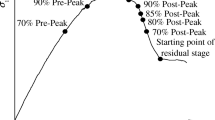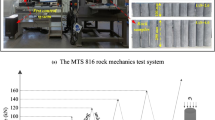Summary
The Stamp-Load Bearing Strength of Rock An Experimental and Theoretical Investigation
Though the stamp-load bearing strength of rock is one of the more relevant rock properties in many mining problems it has been neglected in comparison with the efforts devoted to the strength of rock under uniform compression. As stamp-load bearing experiments offer a simple and effective means for studying the strength of rock under triaxial conditions the bearing strength of the rock has been investigated in detail. Using fundamental equations derived by Love and Sneddon the axisymmetric stress field induced by the indentation of a flat-ended circular stamp into a plane rock surface has been studied. In addition to the normal representation of a stress field by means of stress trajectories and lines of equal principal stresses, potential fracture zones have been calculated for a typical Witwatersrand quartzite. The theoretical analysis of the stampload bearing problem resulted in the acquisition of a deeper knowledge of the complexity of the induced stress field and the fracture mechanism. It has also been shown that there exist serious restrictions of the elastic treatment of this problem.
In order to get a more detailed understanding of the actual failure mechanism and to establish the effects of the non-linear behaviour of rock near to failure some rock specimens were instrumented with strain gauges and cantilevers to measure surface strains and deflection outside the contact area of the stamp. From these experiments the conclusion can be drawn that lateral expansion of fractural rock is an integral part of the failure of rock under stamp loads. Based on these measurements a qualitative model of the failure process has been developed.
The experimental work on the stamp-load bearing strength of rock has resulted in the following findings:
-
1.
The load-displacement curve of the stamp-loading experiments is more sensitive to changes in rock properties than that obtained from compression tests.
-
2.
The stamp-load bearing strength of rocks has been found to be affected by the size of the stamp. The size-dependent behaviour of rock is more obvious on brittle than on ductile rocks. It can be described by an experimental law of the formσ st =Q a a, withα being between 0 and −0.5 for ductile and brittle rocks respectively. At large stamp diameters the bearing strength tends towards a constant value of approximately four times the uniaxial compressive strength of rock.
-
3.
A direct relation between the exponentα and the inelastic part of the lateral expansion of rock at failure has been found. This enables the determination of the lateral expansion of rock from stamp-loading experiments using different stamp sizes.
Zusammenfassung
Die Stempeldruckfestigkeit von Gestein Eine experimentelle und theoretische Untersuchung
Die Stempeldruckfestigkeit der Gesteine wurde bislang wenig beachtet, obwohl sie in vielen Bereichen der Bergtechnik von praktischer Bedeutung ist. Neben der rein praktischen Bedeutung der Stempeldruckfestigkeit stellen Stempeldruckversuche ein einfaches und aussagekräftiges Prüfverfahren dar, dessen Vorzug darin liegt, daß es ohne besondere Schwierigkeiten unter Tage angewendet werden kann.
Im theoretischen Abschnitt der Arbeit wird das beim Stempeldruckversuch auftretende Spannungsfeld näher untersucht. Von der Analyse des Spannungszustandes ausgehend, wird der voraussichtliche Bruchvorgang bestimmt. Obwohl der theoretischen Bestimmung der Bruchzonen zahlreiche Vereinfachungen zugrunde liegen, konnten die Kenntnisse der Vorgänge beim Stempeldruckversuch wesentlicht vertieft werden.
Im Anschluß an den theoretischen Abschnitt werden eingehende Untersuchungen zum Studium des tatsächlichen Bruchvorganges beschrieben und ein qualitatives Modell desselben entwickelt. Dabei zeigte sich die besondere Bedeutung der Dilatation des Gesteins auf den Bruchvorgang beim Stempeldruckversuch.
Im dritten Abschnitt werden die Ergebnisse zahlreicher Stempeldruckversuche an fünf Gesteinen dargelegt und diskutiert. Um den Einfluß des Stempeldurchmessers auf die Stempeldruckfestigkeit zu erfassen, wurden 4 Stempel mit Durchmessern von 3,8 mm bis 30,5 mm verwendet. Die Ergebnisse dieser Untersuchungen können in drei Punkten zusammengefaßt werden:
-
1.
Unterschiede in den Gesteinseigenschaften kommen beim Stempeldruckversuch deutlicher zum Ausdruck als beim normalen Druckversuch.
-
2.
Der Stempeldruckfestigkeits-Wert wird deutlich von der Größe des Stempels beeinflußt. Dieser Einfluß ist bei spröden Gesteinen ausgeprägter als bei plastischen. Der Einfluß der Stempelgröße auf die Stempeldruckfestigkeit kann durch ein experimentelles Gesetz der Formσ st =Q a a ausgedrückt werden. Der Exponentα liegt zwischen den beiden Grenzwerten 0 und −0,5, wobei der Wert 0 plastischen Gesteinen und der Wert −0,5 spröden Gesteinen entspricht. Mit zunehmendem Stempeldurchmesser nähert sich die Stempeldruckfestigkeit einem konstanten Wert, der ungefähr dem Vierfachen der einaxialen Druckfestigkeit entspricht.
-
3.
Zwischen dem Exponentenα und dem inelastischen Anteil der Querverformung eines Gesteins beim Überschreiten der maximalen Gesteinsfestigkeit existiert ein direkter Zusammenhang. Dies ermöglicht eine indirekte Bestimmung der Querverformung der Gesteine mit Hilfe von Stempeldruckversuchen.
Résumé
La résistance à la compression des roches déterminée au moyen d'un poinçon Etude expérimentale et théorique
La résistance à la compression au moyen d'un poinçon était jusqu'à présent peu considérée quoiqu'elle soit d'importance pratique en beaucoup de domaines de la technique minière. Outre la signification pratique de la résistance à la compression, les essais de poinçonnement ont l'avantage d'être une méthode d'essai simple et informative, applicable en souterrain sans grandes difficultés.
Dans la partie théorique, le champ des contraintes qui se produit dans l'essai de compression au moyen d'un poinçon, est examiné plus en détail. Partant de l'analyse des distributions des contraintes, le processus de rupture peut être déterminé. Malgré les nombreuses simplifications concernant la détermination théorique des zones de rupture, on a pu obtenir un remarquable approfondissement des connaissances sur le déroulement de l'essai de poinçonnement.
A la suite de la partie théorique, des études du processus véritable de rupture et le développement d'un modèle qualitatif de la rupture sont décrits. Dans le cadre de ces analyses, l'importance dominante de la dilatation de la roche pour le processus de la rupture dans l'essai de poinçonnement a été mise en évidence.
Les résultats de nombreux essais sont décrits et discutés dans la troisième partie. Au total 5 sortes de roche ont été examinées. Pour évaluer l'influence du diamètre du poinçon sur la résistance à la compression, 4 poinçons de diamètres allant de 3,8 jusqu'à 30,5 mm ont été utilisés. Les résultats de ces analyses peuvent être résumés en trois points:
-
1.
Les différences dans les qualités des roches se montrent plus distinctement qu'avec l'essai ordinaire de compression.
-
2.
La résistance à la compression au moyen d'un poinçon est influencée clairmont par la dimension du poinçon, cette influence est plus nette pour des roches fragiles que pour les roches plastiques. L'influence de la dimension du poinçon se laisse exprimer par la loi expérimentaleσ st =Q a a. L'exposantα varie entre les valeurs limites 0 et −0,5, la valeur 0 correspondant aux roches plastiques et la valeur de −0,5 aux roches fragiles. Lorsque le diamètre du poinçon augmente, la résistance à la compression au moyen d'un poinçon tend vers une valeur constante, environ quadruple de celle de la résistance à la compression uniaxiale.
-
3.
Entre l'exposantα et la part inélastique de la déformation latérale d'une roche à la rupture existe une relation directe. Ceci rend possible une détermination indirecte de la déformation latérale d'une roche à l'aide de l'essai de poinçonnement.
Similar content being viewed by others
References
Coates, D. F., and M. Gyenge, Plate load testing on rock for deformation and strength properties, Department of Mines and Technical Surveys, Mines Branch, Ottawa-Canada, Divisional Report FMP 65/75.
Crouch, S. L., Experimental determination of volumetric strains in failed rock, Int. J. Rock Mech. Min. Sci.7 1970, 589–603.
Davies, R. M., The determination of static and dynamic yield stresses using a steel ball, Proc. Roy. Soc., 197 A, 1949, 416–432.
Cook, N. G. W., K. Hodgson, and H. Wagner, The effectiveness of boundary pillars as water barriers, Chamber of Mines of South Africa Research Report 40/69, 1969.
Harding, J. W., and I. N. Sneddon, The elastic stresses produced by the identation of the plane surface of a semi-infinite elastic solid by a rigid punch, Cambridge Phil. Soc. Proc.41 1945, 16–26.
Jaeger, J. C., Punching tests on discs of rock under hydrostatic pressure, J. Geophys. Res.67 (1), 1962, 369–373.
Jaeger, J. C., and N. G. W. Cook, Fundamentals of Rock Mechanics, Methuen, 1969.
Jaeger, J. C., Elasticity, Fracture and Flow, Methuen's Monographs on Physical Subjects, Methuen, 1964, 184.
Jahns, H., The bearing capacity of the rock strata serving as an abutment for pit supports, Glückauf94 41–42, 1958, 1479–1495.
Jenkins, J. D., Some investigations into the bearing capacities of floors in the Northumberland and Durham coal fields, Trans. Inst. Min. Engr.117 1957/58, 726–738.
Jenkins, J. D., A laboratory and underground study of the bearing capacity of mine floors, Congr. Rock Mechanics, Paris, 1960, Section C5.
Love, A. E. H., The stress produced in a semi-infinite solid by pressure on part of the boundary, Roy. Soc. Phil. Trans.228 A, 1929, 377–420.
Roesler, F. C., Indentation hardness of glass as an Energy Scaling Law, Phil. Soc. Proc.69 B, 1956, 55–60.
Sneddon, I. N., Boussinesq's problem for a flat-ended cylinder, Cambridge Phil. Soc. Proc.42, 1946
Wiebols, G. A., J. C. Jaeger, and N. G. W. Cook, Rock property tests in a stiff testing machine, Proc. Tenth Symposium Rock Mechanics, University of Texas at Austin, 1968.
Author information
Authors and Affiliations
Additional information
With 16 Figures
Rights and permissions
About this article
Cite this article
Wagner, H., Schümann, E.H.R. The stamp-load bearing strength of rock an experimental and theoretical investigation. Rock Mechanics 3, 185–207 (1971). https://doi.org/10.1007/BF01238179
Received:
Issue Date:
DOI: https://doi.org/10.1007/BF01238179




